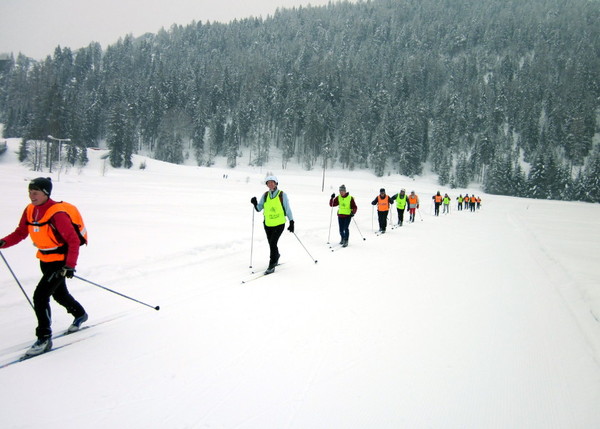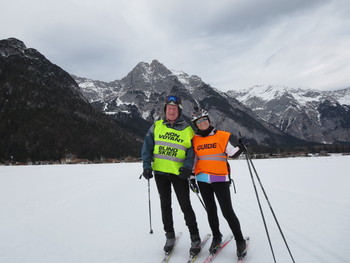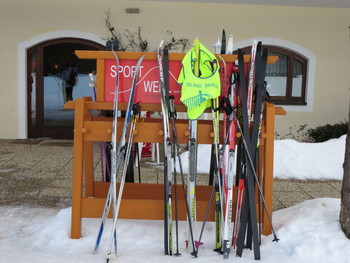The Experience of a Rookie Guide by Sheila Tucker
[This article first appeared in LRNSC's June 2014 newsletter]
 Ski Guiding Visually impaired Skiers Photo: Pam Curwen
Ski Guiding Visually impaired Skiers Photo: Pam Curwen
Cross country skiing with your eyes closed!
Do you remember your first snowplough, the number of times you fell practising and then the satisfaction of eventually being in control? Then almost going back to square one in difficult icy conditions and the anxiety of seeing ice and hearing the skis scrunch on it. Now imagine doing all this with your eyes closed.
It is impossible to fully simulate being visually impaired but just imagine how much more difficult and stressful it would be. In addition it is not possible to ski without a guide.
What do the Visually Impaired Skiers get out of Skiing?
Being privileged to spend time with a group of visually impaired skiers in the 2013/2014 ski season, all the skiers that I spoke to loved the freedom of being able to move independently without being tethered in some way to a guide, because the tracks actually guide them, unlike the openness of a footpath, for example.
For most the exhilaration of being able to move independently at speed was also very exciting. Good exercise, a sense of terrain and countryside and the ability to switch off from the rigours of normal life were also very important.
Cross country ski guiding - what's it all about?
Not knowing quite what to expect I responded to the call for sighted ski guides which was posted in London Region Nordic Ski Club’s autumn Newsletter. I contacted Linda Gaitskell (one of the visually impaired skiers) to find out what was involved and what might be expected of me, if I volunteered.
It was basically to classic ski with a visually impaired skier, keeping them informed of changes in terrain. There would be no expectation that I would teach; the leader of the group is Pam Curwen, a BASI trained Nordic Ski Coach, who gives individual tuition to the visually impaired skiers and is also responsible for pairing up sighted guides (referred to as the guides) with visually impaired skiers (referred to as the skiers), choosing ski locations and routes which take into account the abilities of the individual skiers. All very easy going, apparently, skiing as a group of friends with no one expected to ski with anyone faster than they felt comfortable with.
Though with various skiing abilities, all skiers had skied before on Vitalise holidays. This company had taken over the venture from Guide Dogs for the Blind several years previously but after a number of successful trips had decided not to continue organising these holidays after 2012. A number of skiers and experienced guides had then got together with the coach and decided to organise their own holiday- a week in Seefeld, Austria at the beginning of February 2014.
Seefeld 2014 - would it be a glide too far?
So, I volunteered and didn’t give it much further thought until departure day loomed. Had I put my hand up before engaging my brain? Would I be able to cope or was this a step (a glide?) too far this time?
I needn’t have worried. We were a group of 15; a coach, 6 skiers and 8 guides, 3 of whom were new to guiding. The first day was spent together as a group with the new guides being ‘broken in gently’ and able to observe the experienced ones and then have a go themselves on relatively easy tracks and terrain. By Day 2 we were paired off (and with a different skier each day) and from then on skied in small groups of four to six, with individual lessons, for the skiers, from the coach, being customised and fitted in and amongst.
What attributes do you need to be a guide?
 Jimmy Milhench and Sheila Tucker at LeutaschThe most important is to be able to cross country ski in classic style. It sounds obvious, but in previous years new guides have turned up who have never cross country skied before! In particular you need to be able to ski in control downhill, remembering at all times to observe where the skier is going and with an awareness for everything that is going on around you.
Jimmy Milhench and Sheila Tucker at LeutaschThe most important is to be able to cross country ski in classic style. It sounds obvious, but in previous years new guides have turned up who have never cross country skied before! In particular you need to be able to ski in control downhill, remembering at all times to observe where the skier is going and with an awareness for everything that is going on around you.
You also need to be ski fit. My experience with this group of skiers was that they took pride in their fitness and the necessary measures to ensure that they were fit enough to enjoy their holiday. Be warned, that conversations at dinner often centred on treks to Everest Base Camp and similar achievements!
What position do you ski guide from?
Nothing complicated in this and it is generally the skier who decides. From the front, from the back or alongside (where double tracks or suitable terrain outside the tracks allow). My impression was that where the skier had some sight, however limited, they preferred to have the guide in front of them. Skiers with no sight preferred to have their guide behind them or alongside them, but wherever the guide skis they need to stay close so that the skier can clearly hear their instructions and ‘feel’ that they are in contact.
How do you Ski Guide?
First and foremost we were given Rules of the Track applicable to every skier. It was a very opportune reminder of how we all should ski e.g. ski in control, ski in right hand tracks, overtake on the left, consideration for other track users, falls, accidents, stopping and other safety considerations etc.
Skiers and Guides wear fluorescent tabards for added safety to raise awareness with fellow skiers.
More specifically a standard Guiding Vocabulary and Methods have been developed which form a basic system for guiding visually impaired skiers. This group do not use radio microphones as seen in the Winter Paralympic Games. Voice commands, then, need to be kept simple, speaking loudly and clearly, remaining close with plenty of space between pairs so that skiers can hear their guide and there is less chance of a collision.
Here are some examples of specific verbal commands (from “Cross Country Skiing-Guiding and Vocabulary” written by Pam Curwen):
| COMMAND | PURPOSE | |
|---|---|---|
| STOPPING | ||
| EMERGENCY STOP | ||
| SIT! | Lower bottom and sit | |
| Stop | Quick stop in control | |
| Slow and stop | Controlled stop in own time | |
| MOVING INTO TRACKS | ||
| Side step right/left | Repositioning sideways | |
| Right ski in left track | Information | |
| STEERING IN TRACK | ||
| Tracks going right/left ahead | Prepares skier for curves in track | |
| Gentle curve | More information | |
| Tracks going left, left, left | Directing until around curve |
This gives just a flavour of the Guiding Vocabulary. However I think that by
far my favourite command is “brushing timber” to warn of branches at head height!
What do the Guides get out of Guided skiing?
All the guides enjoyed the camaraderie and the feeling that this was not a self-indulgent holiday; everyone looked out for everyone else. Those guides who had been coming for many years enjoyed spending time with their skier friends and they had developed some life-long friendships. Combining a love of skiing with volunteering was a bonus. Helping people to expand their horizons was important, sharing their experience and, in the case of a ski instructor who was a guide, the intellectual challenge of adapting their skills to best help the skiers.
For me it was the opportunity to ski close enough to chat with people - how often do we do that when we ski? I am sure my track and terrain reading improved because another person was dependent on them and having seen how unperturbed most of the skiers were by falls I think I am a bit less of a wimp about that myself now!
My lasting memories though will be of the wide smile or tear when a skier achieved a goal that they had set themselves!
What next - could you be a ski guide?
 This week was a challenge but this group of cross country skiers are truly inspiring and full of life. These holidays will only continue with enough volunteer guides. Do you think that could be you? If so please get in touch with me.
This week was a challenge but this group of cross country skiers are truly inspiring and full of life. These holidays will only continue with enough volunteer guides. Do you think that could be you? If so please get in touch with me.
Sheila Tucker
London Region Nordic Ski Club & Cairngorm Biathlon Nordic Ski Club
